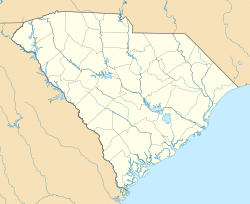
Whitehall is a historic home located at Aiken, South Carolina. It was constructed about 1928 for Robert R. McCormick, one of the owners of the Chicago Tribune.

The Samuel Russell House is a neoclassical house at 350 High Street in Middletown, Connecticut, built in 1828 to a design by architect Ithiel Town. Many architectural historians consider it to be one of the finest Greek Revival mansions in the northeastern United States. Town's client was Samuel Russell (1789-1862), the founder of Russell & Company, the largest and most important American firm to do business in the China trade in the 19th century, and whose fortunes were primarily based on smuggling illegal and addictive opium into China.

Methodist Episcopal Society of Tyringham is a historic church at 128-130 Main Road in Tyringham, Massachusetts, and is presently the only church standing in the community. The property includes a Greek Revival church building built in 1844, and a parsonage house next door. Between 1844 and 1907, the church was also used for town meetings. The property was listed on the National Register of Historic Places in 2000.

The Greenville Presbyterian Church is located on NY 32 just north of its intersection with NY 81 in Greenville, New York, United States. Its three buildings on two acres were listed on the National Register of Historic Places (NRHP) in 1985.
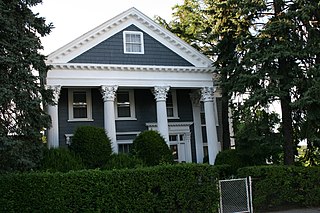
The Arad Alexander House is a historic house at 53 Waverly Street in Worcester, Massachusetts. Built about 1845 and moved in the 1860s, it is one of the city's most elaborate Greek Revival residences, and may have been designed by prominent local architect Elias Carter. It was listed on the National Register of Historic Places on March 5, 1980.

Hyde Park Dutch Reformed Church is located on US 9 in the center of Hyde Park, New York, United States, just north of the post office and the junction with Market Street at the center of town. It is a complex of several buildings on a 2-acre (0.81 ha) lot.

The house at 356 Albany Avenue in Kingston, New York, United States is a frame house built near the end of the 19th century. It is in the Queen Anne architectural style.

The former U.S. Post Office in Canandaigua, New York, is located on North Main Street. It is a Classical Revival granite structure built in 1910 and expanded in 1938. It was listed on the National Register of Historic Places both as a contributing property to the Canandaigua Historic District in 1984 and individually in 1988, as part of a Multiple Property Submission of over 200 post offices all over the state.

The Centre Congregational Church is a historic Congregational church on Province Road in Gilmanton, New Hampshire. Built in 1826–27, it is one of the region's best examples of a late Federal-period church. It was listed on the National Register of Historic Places in 1983.

The East 80th Street Houses are a group of four attached rowhouses on that street in the New York City borough of Manhattan. They are built of brick with various stone trims in different versions of the Colonial Revival architectural style.

The Town Hall of Sandwich, New Hampshire, is located at 8 Maple Street in the village of Center Sandwich. Built in 1913, it is a handsome example of Colonial Revival architecture, and has been a prominent focal point of the town's civic and social life since its construction. The building was listed on the National Register of Historic Places in 1980.
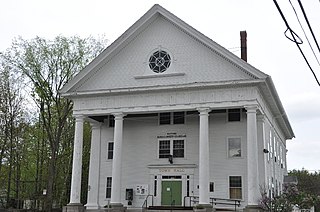
The Bedford Town Hall is located at 70 Bedford Center Road in Bedford, New Hampshire. Built in 1910, it is a prominent early work of Chase R. Whitcher, a noted architect of northern New England in the early 20th century. The building is the third town hall to stand on this site, and was listed on the National Register of Historic Places in 1984.

The Wakefield Public Library serves the town of Wakefield, New Hampshire. It is located at 2699 Wakefield Road in the Wakefield Village, in an architecturally distinguished Colonial Revival building donated to the town by educator and politician Seth Low. The building was listed on the National Register of Historic Places in 1984.

The Henry Sherburne House is a historic house at 62 Deer Street in Portsmouth, New Hampshire. Built about 1766, it is a well-preserved example of late Georgian architecture in the city, distinctive for its scrolled pediment entrance surrounded, the only in situ period example of its style. The house was listed on the National Register of Historic Places in 1972.

The Enfield Town Meetinghouse is a historic Greek Revival style meeting house located on Enfield Street at South Road in Enfield, Connecticut. Completed in 1775 and moved and restyled in 1848, it hosted the municipal government until the 1920s. Now managed by the local historical society as a museum, it was listed on the National Register of Historic Places in 1974.
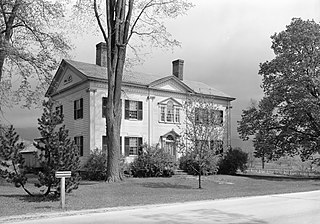
The Munro-Hawkins House is a historic house on Vermont Route 7A in southern Shaftsbury, Vermont. Built in 1807, it is a well-preserved example of transitional Georgian-Federal period architecture, designed by local master builder Lavius Fillmore. It was listed on the National Register of Historic Places in 1973.
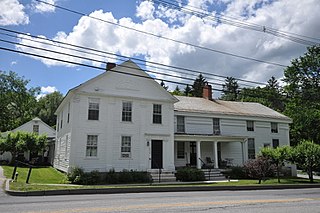
The Pratt-McDaniels-LaFlamme House is a historic house at 501-507 South Street in Bennington, Vermont. Built about 1800, this Federal period building encapsulates the changing residential trends in the town over a 200-year historic, starting as a farm house, then that as a businessman, and eventually subdivided into worker housing. It was listed on the National Register of Historic Places in 2002.
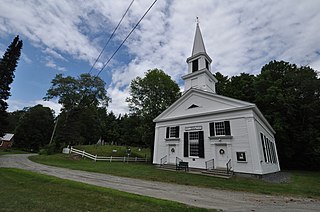
The West Fairlee Center Church is a historic church building at Middlebrook and Bear Notch Roads in West Fairlee, Vermont. Built in 1855, it is a fine and little-altered example of rural Greek Revival architecture, also notable for the association of its congregation with Nathaniel Niles, a prominent local minister, landowner, and politician. It was listed on the National Register of Historic Places in 2002.

The Huntington Lower Village Church, also known historically as the Huntington Union Meeting House, is a historic church building at 2156 Main Road in Huntington, Vermont. Built in 1870, it is a fine late example of Greek Revival architecture. It now houses the Huntington Public Library and serves as a community center. It was listed on the National Register of Historic Places in 1984.

The Dr. Andrew Castle House, also known as the Castle-Russell House, is a historic house at 555 Amity Road in Woodbridge, Connecticut. Built in 1838, it is a locally distinguished example of high-style Greek Revival architecture, and is notable as the home of three prominent local physicians. It was listed on the National Register of Historic Places in 2000.

